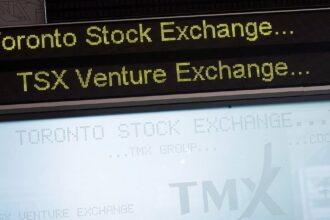The markets closed sharply lower Wednesday as investors grappled with a trifecta of concerns spanning geopolitical tensions, monetary policy uncertainty, and renewed technology sector friction. The S&P 500 dropped 0.95%, while the tech-heavy Nasdaq Composite tumbled 1.4%, marking its worst performance since early August.
“We’re seeing a perfect storm of risk factors converging at once,” said Marcus Reynolds, chief market strategist at Cornerstone Investments. “Iran tensions have markets on edge, the Fed’s path forward remains unclear, and the ongoing tech battle between the U.S. and China is intensifying.”
Wall Street grew increasingly anxious as President Trump weighed potential military responses to Iran following attacks on Israel, creating significant uncertainty in energy markets. Oil prices surged nearly 3% on fears of supply disruptions, with Brent crude touching $76 per barrel before settling at $75.62.
Meanwhile, Federal Reserve officials delivered mixed signals about the pace of future rate cuts after September’s substantial 50-basis-point reduction. Fed Governor Michelle Bowman expressed concern that the aggressive cut might have been premature, while Chicago Fed President Austan Goolsbee suggested the central bank should remain “nimble” as economic data evolves.
“The market had priced in a clear path of steady rate cuts,” noted Eleanor Simmons, economist at Pacific Capital Group. “But now we’re seeing divergent views from Fed officials, creating volatility as investors reassess their expectations.”
The technology sector faced additional pressure after reports that the Biden administration is considering further restrictions on semiconductor exports to China. Chip manufacturers bore the brunt of the selling, with Nvidia dropping 4.7%, AMD falling 3.8%, and the Philadelphia Semiconductor Index sliding 2.9%.
Chinese chip stocks listed in the U.S. faced even steeper declines, with some falling more than 6% as investors feared escalating tensions would disrupt the global technology supply chain and threaten future revenues.
“The semiconductor industry has become the frontline in U.S.-China strategic competition,” explained Dr. Wei Zhang, technology policy analyst at Global Research Partners. “Each new restriction creates ripple effects throughout the entire tech ecosystem.”
The VIX, Wall Street’s fear gauge, jumped 15% to its highest level since early August, reflecting heightened investor anxiety amid these converging concerns.
Looking ahead, market participants will closely monitor President Trump’s decision on Iran, upcoming economic data that could influence the Fed’s rate path, and any official announcements regarding technology export controls.
“What makes this situation particularly challenging is that we’re dealing with three separate but interconnected risk factors,” said Reynolds. “Each alone could move markets, but together they create significant uncertainty that investors simply can’t ignore.”
For the latest market updates and analysis, visit CO24 Business or follow our breaking coverage at CO24 Breaking News.











